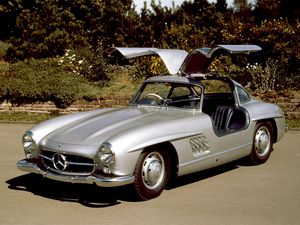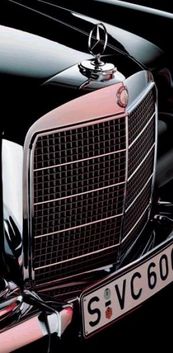.
Mercedes-Benz 300SL
- This article is about the car produced from 1952 to 1963, for other cars with the same name, see Mercedes-Benz SL-Class.

| |
| Mercedes-Benz 300SL | |
|---|---|
| Mercedes-Benz | |
| aka | W198 Mercedes Benz 300 SLR |
| Production | 1952 - 1963 1400 units |
| Class | sports car |
| Body Style | 2 door coupé, roadster |
| Length | 178 in (4520 mm) |
| Width | 70.5 in (1790 mm) |
| Height | 51.1 in (1300 mm) |
| Wheelbase | 94.5 in (2400 mm) |
| Weight | 2352 lb (1093 kg) |
| Transmission | 4-speed Manual, RWD |
| Engine | 3 litre (2995cc) SOHC Mercedes Inline-6 with Bosch mechanical fuel injection |
| Power | 215 hp @ 5800 rpm 170 lb-ft of torque @ 3800 rpm |
| Similar | Aston Martin DB 3 Jaguar E-type |
| Designer | {{{Designer (lead designer if it was a team effort)}}} |
The Mercedes-Benz 300SL is a two-seat, closed sports car with characteristic gull-wing doors, and later, offered as an open roadster.
Built by Daimler-Benz AG and internally numbered W198, the road version of 1952 was based (somewhat loosely) on the company's highly successful competition-only sports car of 1950, the Mercedes-Benz 300SL (W194) which had less power, as it still had carburetors.
This model was suggested by Max Hoffman. Because it was intended for customers whose preferences were reported to Hoffman by dealers he supplied in the booming, post-war American market, it was introduced at the 1954 New York Auto Show—unlike previous models introduced at either the Frankfurt or Geneva shows. The 300SL was best known for both its distinctive gullwing or butterfly wing doors and for being the first-ever gasoline-powered car equipped with fuel injection directly into the combustion chamber. The gullwing version was available from March 1955 to 1957. In Mercedes-Benz fashion, the "300" referred to the engine's cylinder displacement, in this case, three liters. The "SL", as applied to a roadster, stood for "Sport Leicht" or "Sport Light."
More widely produced (25,881 units) and starting in 1954 was the similar looking 190SL with a 105hp 4cyl engine, available only as roadster (or with an additional hardtop, as Coupe Roadster). The 190SL was equivalent to today's SLK in its market positioning when compared to the SL. Production for both the 190SL and 300SL ended in 1963 when the 230SL was introduced.
A race car for the street
| Wikimedia Commons has media related to: |
The gullwing doors, hinged at the roof and so named because the open doors resembled a bird's outstretched wings, were implemented as such to accommodate for the car's tubular chassis, designed by DBAG's chief developing engineer, Rudolf Uhlenhaut. Part of the chassis passed through what would be the lower half of a standard door. This tubular chassis was a necessity, as the original car was designed solely for racing and needed to be as light as possible due to the rather underpowered original, carbureted, engine, while still providing a high level of strength. This required the driver and any passengers to do some gymnastics to get in or out of the car, usually by sitting on and sliding across the wide door sill. A steering wheel with a tilt-away column made the process considerably easier.
It was Max Hoffman, Daimler-Benz's official importer in the USA, who convinced DBAG management in Stuttgart that a street version of the 300SL would be a commercial success, especially in the US. Hoffman's prediction was correct since more than 80% of the vehicle's total production of approximately 1400 units were sold in the US, making the Gullwing the first Mercedes-Benz which sold in bulk outside its home market. The 300SL is credited for changing the company's image in America from a manufacturer of solid, but staid, automobiles to that of a producer of sporty cars.
Built completely with steel except for the aluminium bonnet (hood), doors and boot (trunk), the 300SL could have been ordered with an all-aluminium outer skin, saving 80 kg (176 lb), but at tremendous added cost.
First with fuel injection
The engine, canted at a fifty-degree angle to the left to allow for a lower hoodline, was the same 3.0 liter straight-6 as the regular four-door 300 but with a Bosch mechanical fuel injection system that more than doubled its power from 86 kW (115 hp) in its original carbureted trim to 180 kW (240 hp) at 6100 rpm. This new injection system, a first in any gasoline-powered car (apart from the rather small Gutbrod where the Mercedes engineers had to work after the war), allowed a top speed of 260 km/h (161 mph) depending on gear ratio (several options), making the 300SL the fastest production car of its time. The maintenance requirements were high as, unlike the current electrically powered fuel injection systems, the mechanical fuel pump would continue to inject gasoline into the engine during the interval between shutting off the ignition and the engine's coming to a stop; this gasoline was of course not burned, and washed the oil from the cylinder walls and ended up diluting the engine's lubricating oil, particularly if the engine was not driven hard enough nor long enough to reach a temperature high enough to evaporate it out of the oil. Exacerbating the problem were the large oil cooler as well as the large volume of oil (10 liters), both oriented more to racing than to street driving, which virtually guaranteed that the oil would not reach a high enough temperature. In practice, many street drivers would block off airflow through the oil cooler, and the recommended oil change interval was 1,000 miles.
Aerodynamics played an important role in the car's speed. Mercedes-Benz engineers even went so far as to place horizontal "eyebrows" over the wheel openings. Given the car's overall styling, it has been suggested that the eyebrows were added to make the car more appealing to American buyers rather than to serve any functional purpose since American cars of the period were rather flamboyant by comparison to the 300SL. Unlike many cars of the 1950s, the steering was rather precise and the four-wheel independent suspension allowed for a reasonably comfortable ride and markedly better overall handling. However, the rear swing axle, jointed only at the differential, not at the wheels themselves, could be treacherous at high speeds or on imperfect roads due to extreme changes in camber.
Racing history and the 300SL today
In 1952, the 300SL racing history includes overall wins at Le Mans, Berne, Nürburgring, and Mexico's Carrera Panamericana. It also managed second and fourth places at its first outing, the Mille Miglia in 1952. These successes, especially those on the high speed open road races, were rather surprising as the engine was fitted with carburetors and produced only 175 hp, less than the competiting models of Ferrari and Jaguar, and less than the road car later on. But low weight and low aerodynamic drag made the 300SL fast enough to be a challenger. Superior reliability made it a winner.
The 1955 sports racing car, named Mercedes-Benz 300SLR, was not based on the road 300SL, but on the Formula 1 Mercedes-Benz W196 race car with 8 cylinders in line. The engine capacity was enlarged from 2500cc to 3000cc, and it was powered by standard gasoline rather than a fuel mix including methanol. It won the 1955 Mille Miglia (with Stirling Moss at the wheel) with an average speed of 157.65 km/h in 1,600 km (97.96 mph in 994 miles). The 300SLR scored additional victories in Germany, Sweden, Ireland and at the Targa Florio in Sicily, and won the world championship for sports cars in the constructors' ranking. The 300SLR was withdrawn from the 1955 Le Mans disaster while leading, after a horrific accident involving one of the team's cars killed 82 spectators. In 2005, a 300SL Gull Wing driven by 87 year old John Fitch, one of the SLR Factory drivers in the 1955 Le Mans race and the GT class winner in MM driving a factory prepaired 300 SL Gull Wing, attempted to set a new F/GT class record for land speed record at Bonneville Speedway, but was thwarted by a balky fuel pump that limited top speed to 150 mph. After the run, the team vowed to return for a second attempt the next year. Fitch noted that he had driven these cars faster than that at night, in the rain, on the road with 60 other cars. The attempt is documented in the film Gullwing at Twilight: The Bonneville Ride of John Fitch, which was aired on PBS [1].
Today, the 300SL with its unique doors and technological firsts is considered one of the most collectible Mercedes-Benz models of all time, with prices reaching well past the US$400,000 mark. In addition, Sports Car International magazine ranked the 300SL as the number 5 sports car of all time.
The Mercedes-Benz SLR McLaren is inspired by these 1950s automobiles.
References
| Wikimedia Commons has media related to: |
- Mercedes Momentum magazine, Fall 2004 edition
- Sports and Classic Cars, Bonanza Books, New York. 1955, Borgeson G. and Jaderquist E.
- Mercedes-Benz.com
- Ritz Site: Pictures and information from an enthusiast's angle
- History, Pictures, Videos, Brochures etc.
| Mercedes-Benz road car timeline, 1946-1970s Template:Edit | later--> | ||||||||||||||||||||||||||||||||||||
| Class | Type | 1940s | 1950s | 1960s | 1970s | ||||||||||||||||||||||||||||||||
| 6 | 7 | 8 | 9 | 0 | 1 | 2 | 3 | 4 | 5 | 6 | 7 | 8 | 9 | 0 | 1 | 2 | 3 | 4 | 5 | 6 | 7 | 8 | 9 | 0 | 1 | 2 | 3 | 4 | 5 | 6 | 7 | 8 | 9 | ||||
| 4-cylinder | sedan | W136/W191 | W120/W121 | W110 | W115 | ||||||||||||||||||||||||||||||||
| roadster | W121 | ||||||||||||||||||||||||||||||||||||
| 6-cylinder | sedan | W187 | W105/W180/W128 | W111 | W114 | W123 | |||||||||||||||||||||||||||||||
| coupe | W187 | W180/W128 | |||||||||||||||||||||||||||||||||||
| large | sedan | W186/W189 | W111 | W108/W109 | W116 | ||||||||||||||||||||||||||||||||
| luxury | W188 | W112 | |||||||||||||||||||||||||||||||||||
| limousine | W186/W189 | W112 | W100 (600) | ||||||||||||||||||||||||||||||||||
| sports | roadster | W198 | W113 | R107 | |||||||||||||||||||||||||||||||||

